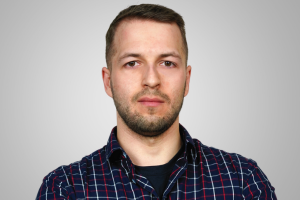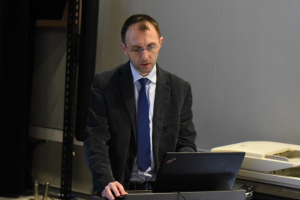Strona główna


Konferencja MATLAB EXPO Polska to wydarzenie będące częścią cyklu organizowanego przez firmę MathWorks. Uczestnicy konferencji mogą dowiedzieć się, jak efektywnie wykorzystać oprogramowanie MATLAB i Simulink do własnych projektów. Prelegentami będą inżynierowie z firm MathWorks i ONT, a także użytkownicy, zarówno komercyjni jak i akademiccy, którzy podzielą się swoimi doświadczeniami.
Prezentowane treści będą dotyczyć wykorzystania narzędzi w inżynierii cyfrowej. Zagadnienia, które pojawią się podczas konferencji obejmują najnowsze trendy w przemyśle takie, jak projektowanie oparte o model (Model-Based Design), automatyczna generacja kodu produkcyjnego lub wykorzystanie modelu pracy low-code opartego o interfejsy graficzne. Zaprezentowane zostaną przykłady wykorzystania MATLABa i Simulinka z dziedzin sztucznej inteligencji, elektryfikacji czy autonomizacji pojazdów.
Ramowy program konferencji
09:00 – 09:15 – Otwarcie
09:15 – 10:00 – Damian Kowal, MathWorks
Model-Based Design has been a reliable and powerful framework for designing complex systems for more than two decades. Today’s engineers are confronting new workflows influenced by trends in software development, the integration of AI, and cloud computing. Learn how MathWorks is investing in Model-Based Design to deliver critical capabilities to automate design tasks, prevent defects, and scale to increasingly complex digital systems.
10:00 – 10:45 – Konrad Kolski, Mateusz Łabęcki
Prezentacja poświęcona jest przedstawieniu możliwości środowiska MATLAB w zakresie generacji kodu i wsparcia dla platform sprzętowych opartych na FPGA i procesorach embedded. Podczas wystąpienia przedstawione zostaną m.in. różne podejścia, a także narzędzia dedykowane do łatwej obsługi urządzeń wykorzystywanych w specjalistycznych zastosowaniach takich jak testowanie systemów bezprzewodowych czy sterowanie.
10:45 – 11:00 – Przerwa
11:00 – 11:15
Szczegóły będą podane wkrótce
11:15 – 11:30 – Adam Jabłoński, AGH
Prezentacja przedstawia ścieżkę automatycznego przekształcania m-plików ze środowiska MATLAB na biblioteki źródłowe dla urządzeń z procesorem ARM Cortex-M. Metodologia obejmuje narzędzia Embedded Coder, Code Replacement Toolbox, bibliotekę CMSIS, deployment Wizard oraz Code Replacement Viewer. W prezentacji przedstawione zostaną konkretne przykłady zastosowań.
11:30 – 12:15 – Sebastian Bomberg, MathWorks
The aim of the session is to provide an overview of how MATLAB, Simulink, and Model-Based Design enable you to take advantage of disruptive technologies such as deep learning. We will explore, in detail, the workflow involved in developing, testing, and deploying an AI-based model. These methods use input-output data from the original high-fidelity first-principles model to construct a machine-learning-based ROM that accurately represents the underlying system. We will present a brief overview of a custom certification workflow for machine learning systems based on existing certification standards and walk you through all the steps in the workflow, from defining requirements, managing data, training the model, and verifying its performance to the implementation of the system in hardware and validation of the requirements.
12:15 – 13:30 – Lunch
13:30 – 14:15 – Jaromir Przybyło, ONT
Wystąpienie poświęcone jest przedstawieniu możliwości środowiska MATLAB w zakresie przetwarzania, analizy i rozpoznawania obrazów. Podczas prezentacji zostaną m.in. przedstawione narzędzia MATLABa pozwalające na interaktywną pracę, w tym: import, przetwarzanie i etykietowanie obrazów oraz projektowanie rozwiązań sztucznej inteligencji.
14:15 – 14:45 – Jakub Szyman, ONT
Zagadnienia dotyczące symulacji efektów cieplnych w układach elektrycznych są w centrum zainteresowań wielu podmiotów komercyjnych. Simscape jest narzędziem umożliwiającym ich przeprowadzenie. Stopień rozbudowania modelu w zależności od obszarów zastosowania może obejmować szereg procesów towarzyszących; od wpływu efektów termalnych na parametry przewodnika po modelowanie zjawisk przenoszenia ciepła od strony płynu. Zamodelowane układy można integrować z narzędziami Simulink, w celu doboru układów sterowania układów chłodzenia oraz modelowania awarii, spowodowanych efektem cieplnym. Niniejsza prezentacja ukaże możliwości wykorzystania środowiska Simscape do modelowania efektów cieplnych, występujących w obwodach elektrycznych.
14:45 – 15:15
Szczegóły będą podane wkrótce
15:15 – 15:30 – Przerwa
15:30 – 16:00 – Paweł Siatka, ONT
Wystąpienie poświęcone jest przedstawieniu narzędzi w MATLABie i Simulinku umożliwiających autonomiczne działanie różnego typu pojazdom. Podczas prezentacji zostaną poruszone m.in. kwestie lokalizacji pojazdu i percepcji otoczenia, automatycznego podejmowania decyzji i sterowania.
16:00 – 16:30
Szczegóły będą podane wkrótce
Prelegenci

Sebastian Bomberg
As an application engineer at MathWorks, Sebastian Bomberg supports customers in implementing data science projects. For instance, he develops applications for forecasting, predictive maintenance, IoT, and fleet analytics. To this end, he uses techniques from machine learning as well as big data algorithms and cloud computing. Prior to joining MathWorks, Sebastian worked as development engineer at the aerodynamics and HVAC department of MAN Truck & Bus in Munich. Sebastian Bomberg holds a German degree Diplom-Ingenieur (M.Sc.) in mechanical engineering from Technical University of Munich, where he also worked as a researcher at the Thermo-Fluid Dynamics Group.

Adam Jabłoński
Adam Jabłoński jest profesorem AGH w Krakowie na Wydziale Inżynierii Mechanicznej i Robotyki. Od ponad 15 lat współpracuje z przemysłem w zakresie metod cyfrowego przetwarzania sygnałów oraz systemów monitorowania i diagnostyki maszyn wirnikowych. Jest autorem ponad 100 publikacji naukowych, w tym patentów oraz książki "Condition Monitoring Algorithms in MATLAB", włączonej do programu Mathworks Book Program. Jest absolwentem Central Texas College (USA), który ukończył z tytułem Highest Honors (2004) oraz AGH w Krakowie, gdzie uzyskał kolejno tytuł inżyniera, magistra oraz stopień doktora nauk technicznych i doktora habilitowanego. Od 2018 r. jest członkiem the Board of Directors (International Liaison) stowarzyszenia MFPT (Society for Machinery Failure Prevention Technology, USA). Jest autorem licznych wdrożeń i prowadzi konsultacje w wielu gałęziach przemysłu, audytor Industry 4.0.

Damian Kowal
Damian Kowal is responsible for driving the business development of the Industrial Automation & Machinery industry at MathWorks in the EMEA region. Focusing on identification of technology trends driving energy transition and helping customers unlock their potential and meet their business and technical targets. Prior to joining MathWorks, Damian worked as a principal scientist and project manager at ABB in Sweden, where he conducted research around powertrains for e-mobility and robotics. Damian holds PhD degree in Electromechanical Engineering from Ghent University.

Konrad Kolski
Konrad Kolski pracuje jako inżynier aplikacji w firmie ONT. Na co dzień zajmuje się zagadnieniami związanymi z wykorzystaniem narzędzi MathWorks w metodyce Model-Based Design, modelowaniem i symulacją systemów dynamicznych w tym projektowaniem systemów sterowania, weryfikacją i walidacją w środowisku Simulink oraz automatyczną generacją kodu C wraz z szeroko pojętą współpracą środowisk MATLAB i Simulink z różnymi platformami sprzętowymi. Ukończył studia magisterskie na kierunku Mechatronika w specjalności Projektowanie i Eksploatacja Systemów Mechatronicznych.

Mateusz Łabęcki
Mateusz Łabęcki pracuje na stanowisku inżyniera aplikacji w ONT. Na co dzień zajmuje się przetwarzaniem sygnałów i danych w środowisku MATLAB oraz podejściem Model-Based Design opartym na Simulinku uzupełnionym o generację kodu HDL. Jest również odpowiedzialny za środowisko RoadRunner, które jest wykorzystywane do testowania systemów AD/ADAS.

Jaromir Przybyło
Konsultant i inżynier aplikacji w firmie Oprogramowanie Naukowo-Techniczne. Zajmuje się m.in. analizą i rozpoznawaniem obrazów, technikami uczenia maszynowego i głębokiego oraz obliczeniami równoległymi. Adiunkt w Katedrze Biocybernetyki i Inżynierii Biomedycznej AGH.

Paweł Siatka
Inżynier aplikacji w firmie ONT. Zajmuje się robotyką i pokrewnymi zagadnieniami w MATLABie. Absolwent Inżynierii Mechatronicznej ze specjalizacją Projektowanie Mechatroniczne na Akademii Górniczo-Hutniczej w Krakowie.

Jakub Szyman
Jakub Szyman pracuje jako inżynier aplikacji ds. elektryfikacji i w firmie ONT. Doktor nauk technicznych w specjalności inżynieria chemiczna i procesowa. Zainteresowania: modelowanie matematyczne obiektów w inżynierii chemicznej, w szczególności określanie własności operacyjnych reaktorów fotokatalitycznych.
Informacja o kolejnych prelegentach pojawi się wkrótce.
Rejestracja
Lokalizacja
NYX Hotel Warsaw
Chmielna 71, 00-801 Warszawa

Oprogramowanie Naukowo-Techniczne sp. z o. o.
ul. Pod Fortem 19
31-302 Kraków
- info@ont.com.pl
- +48 126304950
© Copyright 2024 by ONT. All rights reserved.

